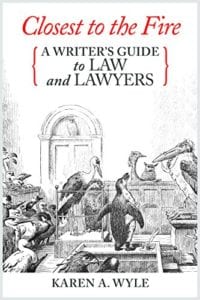
About the Book:
Write about the law — and get it right!
The world of law and lawyers, with its suspense, its moral quandaries, and its ripped-from-the-headlines subject matter, provides wonderful material for fiction. This guide will help writers explore these many story possibilities — while avoiding the also-numerous pitfalls awaiting the unwary author.
Included throughout the book are ideas for stories or story elements based on the content and available for the readers’ use.
Karen A. Wyle is an award-winning appellate attorney with more than thirty years’ experience. A cum laude graduate of Harvard Law School, she worked for law firms and the California Court of Appeal before establishing her solo practice in Bloomington, Indiana. Wyle has filed amicus briefs in the U.S. Supreme Court and seven state supreme courts. She has also written and published five novels.
Read an Excerpt:
Featured in Dec/Jan 2016 Issue: 2015 Indie Best Award Winners
Divorce From Fault to No-Fault
Through the 1960s, married couples in the U.S. could only obtain a divorce based on “fault,” usually meaning misconduct of one (and only one) of the spouses. The grounds included adultery; abandonment; deliberate infliction of physical or emotional pain (“cruelty”); and commission of a felony that landed a spouse in prison. Sometimes, the hardly intentional or culpable ground of “impotence” also sufficed. A separation of residences provided another relatively neutral ground for divorce in some states.
Defenses to an action for divorce included the “them too” defense, known as recrimination. Success resulted in a Pyrrhic victory: the mutually misbehaving couple remained married.
In cases where both spouses wanted out of the marriage, but neither had committed acts necessary for a divorce, it became common to put on a fictional performance in court, with most often the wife testifying that the husband had been physically abusive or unfaithful. Sometimes, the couple would arrange for the wife to come home and find the husband with a supposed lover hired for the occasion, but the wife’s testimony would still contain some falsehoods as to the context of this “discovery.” If the court decided to notice the staged nature of the event, that would constitute “collusion,” and the couple would have the choice of staying married or trying a more convincing performance later on. Or they could bite the proverbial bullet and arrange for one of them actually to commit an action that would justify the divorce. **Either approach could make for colorful fiction, with anything from a farcical to a tragic tone depending on your preference.**
Since another name for false testimony is “perjury,” this situation was quite unsatisfactory.
In January 1970, the governor of California signed the country’s first “no-fault divorce” statute into law. This statute made divorce available to couples who both desired a divorce as well as spouses who were alone in wishing to end the marriage.
The trend took off from there, with all but South Dakota and New York offering some form of no-fault divorce by 1983. New York, the last holdout, accepted no-fault divorce in 2010.
